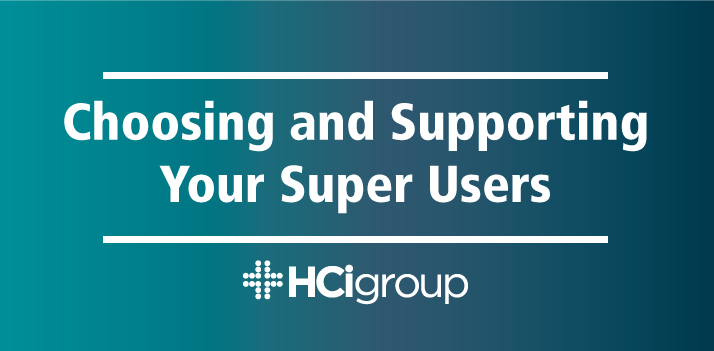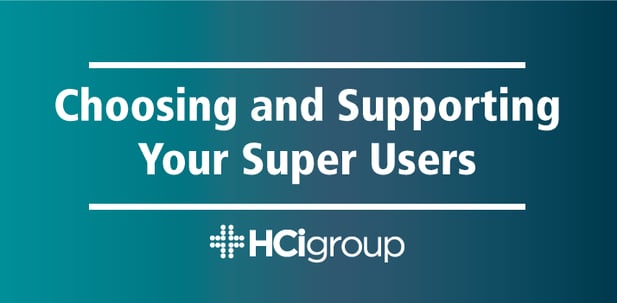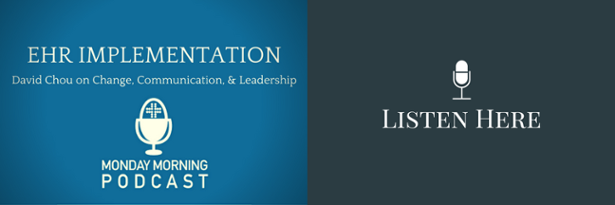EHR Implementation: Choosing and Supporting Your Super Users


Large transformative efforts, like the implementation of a new EHR, will touch every single person in your organization in some way. From transport who ferry individuals around by wheelchair or stretcher, to the CFO, to your patients - everyone will be affected.
Projects such as these are ongoing endeavors, not a single moment in time. For that reason, it is vital that healthcare facilities utilize super users and early adopters to assist in planning, education of their peers, and workflow redesign to help ensure success. At the same time, however, organizations must be prepared to backfill while their super users are away from their dedicated jobs.
HIT and EHR leader Kelly Dungee has experience as an IT director and CIO, and knows exactly why super users and early adopters are of the utmost importance to healthcare organizations during an EHR implementation, as well as how to handle filling the gaps that result from their increased workload.
1) Who Are Early Adopters and Super Users?
There are two key groups of individuals that really need to be included in your effort to transform – early adopters and super users. These two groups will work to carry forward both the champion’s message and the organizational “why” of the implementation into their respective departments, and to their likely constituents.
Having your super users and early adopters on board early helps to build credibility and engage folks in the transformative effort of an EHR implementation. They have to be well-versed in the workflow of their departments, and they have to be able to use that knowledge to assist in tailoring the technology to meet their departmental needs.
So who, specifically, in your healthcare facility, will be your early adopters or super users? Early adopters are the folks who get on board early and spend time delivering the message of the EHR implementation. These individuals are the change-engagers and tinkerers, and they typically like to figure out the new aspects that the new EHR is bringing to your organization.
Super users, on the other hand, have a more formal role. These are usually formally appointed end users, and their duties often entail bringing forward the workflows that are within their departments or units, and tailoring the technology. Super users will bring forward their particular subject matter expertise, and make sure that it is represented in the technology. They will usually have roles to play after implementation, by offering at-the-elbow or overall support post go-live. Your super users will basically be the subject matter experts that help their coworkers navigate through the new EHR.
2) How to Handle their Increased Workload
Your super users and early adopters will now be doing much more than they were before in their usual, day-to-day jobs. Oftentimes, your super users will have to be pulled from their usual jobs in order to assist in various different areas of the implementation. As the project progresses, you’ll often see some individuals who will say “Well, Mary needs to get back to her real job, which was taking care of patients – not implementing this new system.” And while this is understandable, it is important that the organization has ‘Mary’ engaged, because the goals of the implementation are dependent upon the input of the super users, in order to make sure that things are being done completely and accurately.
This of course raises a question: How do you adapt to ‘Mary’ not being at her real job during your implementation? To answer this question, you must look back at the project management triad of time, money, and resources. One way that many organizations deal with this is by setting aside a line item for backfill in their project budget. Backfilling can be accomplished through a variety of different means – by offering part-time employees additional time to work, offering per-diem employees time to work, or by bringing in third parties to do the underlying work of the health system.
A good example of third party assistance involves bringing in perioperative nurses. These nurses are highly skilled and highly trained, and are currently in great demand across the country. They will be able to free someone up from a department, and can help fill your gaps. Overtime is looked at as a four-letter word by many healthcare facilities, so it is vital that your organization look at various different means of backfilling prior to implementing a new EHR.
When planning for an EHR implementation, it is important to remember that no two implementations are the same. Your organization needs to look at the various aspects that will make your specific implementation unique, and plan accordingly. Utilizing super users and early adopters can be greatly beneficial to you during your implementation, because they will know the intricacies of your organization, and can help to make sure that it is successful and smooth for everyone that is involved.

